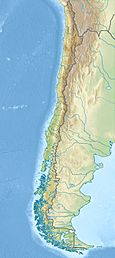Tilocálar
Quick facts for kids Tilocálar |
|
|---|---|
| Highest point | |
| Elevation | 3,109 m (10,200 ft) |
Tilocálar is a group of volcanoes located in Chile, south of a large salt flat called the Salar de Atacama. These volcanoes formed a long time ago, during the Pleistocene period. Tilocálar is made up of a small lava dome, two openings (called vents) that released many thick lava flows stretching for several kilometers, and a special explosion crater. This crater was once thought to be from a meteorite impact, but it's actually volcanic. There are other similar volcanoes close by.
Contents
What is Tilocálar?
Tilocálar is found in the Andes mountains, specifically in the Central Volcanic Zone. It sits at a height of about 3,167 meters (about 10,390 feet) above sea level. It's not just one volcano, but a group of small ones. The name "Tilocálar" comes from the Atacameno language.
The Volcanoes of Tilocálar
There are a few main parts to the Tilocálar group:
- Tilocálar Sur (South Tilocálar): This is the biggest part. It created several large lava flows. It also has ash and rock deposits covering an area of about 3.3 square kilometers (1.3 square miles). This southern part has three volcanic craters lined up, and lava likely came from a lava lake inside.
- Tilocálar North: This part produced one long lava flow, about 4.3 kilometers (2.7 miles) long. It covers an area of about 3.5 square kilometers (1.4 square miles).
- El Maní Lava Dome: Southwest of Tilocálar North, there's a small lava dome called El Maní. It looks like a pile of rocks.
- The Explosion Crater: About 1 kilometer (0.6 miles) south of Tilocálar Sur, there's a special crater. It's also called a maar. This crater is about 300 to 400 meters (980 to 1,300 feet) wide and 50 meters (160 feet) deep. It looks like it used to be filled with water. Scientists first found it in 1976 and thought it might be from a meteorite hitting Earth, but they later found out it was formed by a volcanic explosion.
The lava flows from Tilocálar are very thick, about 50 to 80 meters (160 to 260 feet). The volcanoes are located in a low area with many ridges running north to south. Other volcanoes, like Cerro Tujle and Negro de Aras, are also nearby.
How Tilocálar Formed
The Tilocálar volcanoes grew on top of older volcanic rock called ignimbrites. These rocks are about 3.2 million years old. The area where Tilocálar is located is under pressure from Earth's plates pushing together. A system of faults (cracks in the Earth's crust) running north to south helped the volcano develop.
Scientists have studied the ground under Tilocálar and found areas that conduct electricity well. This might be because of rocks changed by hot water, or leftover melted rock from past volcanic activity.
Volcanic Neighbors
Tilocálar is part of a huge area of volcanoes called the Altiplano-Puna volcanic complex. This area covers more than 50,000 square kilometers (about 19,000 square miles) across Bolivia, Chile, and Argentina. These volcanoes have been active for the last 26 million years, with bursts of activity. The most recent bursts happened about a million years ago at places like Apacheta-Aguilucho volcanic complex, El Tatio, and Purico.
Most of the volcanoes in this large complex produce thick, sticky lava. But Tilocálar is a different type of volcano, called a monogenetic volcano, which usually erupts only once or a few times.
What Tilocálar is Made Of
The lava flows from Tilocálar are made of rock types called andesite and dacite. The lava dome is made of dacite to rhyolite. These rocks are rich in potassium and contain minerals like pyroxene, olivine, and plagioclase. The lava from Tilocálar North and Tilocálar Sur have slightly different makeups. Scientists think that parts of the Earth's lower crust might have helped form the magma (melted rock) that created Tilocálar.
When Tilocálar Erupted
The Tilocálar volcanoes were active during the Quaternary period, specifically in the last 900,000 years. Scientists have used special dating methods to find out that Tilocálar Sur erupted about 730,000 years ago and again about 460,000 years ago.
There are no records of Tilocálar erupting in recent history. Scientists believe that if it were to erupt again, it would likely not cause much harm to people living nearby.
How the Eruptions Happened
Tilocálar North probably formed from just one eruption. Tilocálar Sur, however, was built up over several eruptions. It's thought that an initial explosive eruption sent out ash and rocks, and then lava flows covered some of these deposits. This explosive event was a medium-sized eruption.
The explosion crater was likely formed when steam or gas exploded. This happened when the volcano's opening (conduit) broke open and mixed with underground water.
Other Facts
Tilocálar is also the name of an archeological site (a place where ancient human activity is found) located further north, near the Salar de Atacama. An archeological phase (a period of time in archaeology) is also named after this area.
See also
 In Spanish: Volcán Tilocálar para niños
In Spanish: Volcán Tilocálar para niños


